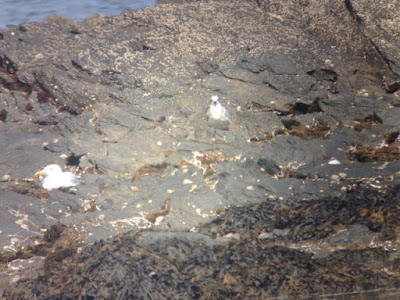Since we've started colour-ringing Cormorants and Great Black-backed Gulls on Mullion Island we've also aimed to read rings on these birds locally and yesterday a few ardent colour-ring readers did a sweep of a few local sites.
Cormorant TBT (ringed on Mullion in April 2016) was at Drift Reservoir, whilst Hayle estuary only produced a single St Ives-ringed Herring Gull. Stithians Reservoir fared slightly better, with three of our Herring Gulls seen; one from St Ives and two from Falmouth, including W:001 which was one of the first birds ringed by the project.
 |
| W:001 as a chick on the roof of Falmouth Marine School in 2013 |
Elsewhere, one of our Herring Gulls was seen at Helston Loe Pool, but was flushed before the combination could be read - by the visiting Dalmatian Pelican!
Further along the coast, closer to Mullion Island, a walk along the cliffs at Halzephron (north of Gunwalloe) is sometimes productive, though another of our Cormorants sat offshore was too distant to confirm. We did manage to get close enough to a group of loafing Great Black-backs to find one colour-ringed bird, but it wasn't from Mullion Island.
Yellow 0JJ6 is a bird ringed as a chick off Herm in the Channel Islands in June 2010 and was seen around the islands until spring 2011. This isn't its first trip to Cornwall though, as it was seen on Hayle Estuary October 2011, with only two sightings since; back on Guernsey in September 2012 and then in France in May 2013. So where it's been for the last three years is unknown.
 |
| The small roost at Halzephron Cliffs, with Mullion Island in the background |














